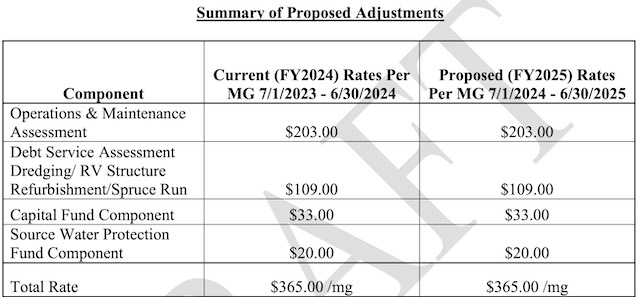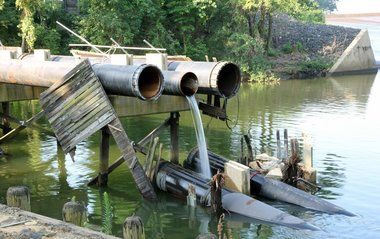Another Example Of The Contradiction Between Murphy DEP Rhetoric And Policy Reality
Th NJ Water Supply Authority (NJWSA) just proposed to retain current water user rates, a move that conflicts with Murphy DEP warnings about the need to make major new investments in drinking water infrastructure to respond to longstanding failure to invest and new challenges posed by climate change and new advanced treatment to remove hundreds of unregulated toxic chemicals.
The NJWSA proposal is scheduled to be published in the New Jersey Register dated January 2, 2024. A copy of the proposal is available from: the Department’s website https://dep.nj.gov/wp-content/uploads/rules/proposals/proposal-20240102a.pdf, the NJWSA website (http://www.njwsa.org), and LexisNexis free public access to the New Jersey Register, (www.lexisnexis.com/njoal).
We constantly read of multi-billion dollar deficits in NJ’s water infrastructure.
These huge deficits are projected to grow significantly due to the need for additional investments to respond to climate change and advanced treatment to remove unregulated toxic chemicals and toxic byproducts of harmful algae blooms.
The Joint Legislative Task Force On Drinking Water Infrastructure Report (2018) issued a stern warning:
New Jersey is facing a hidden infrastructure crisis underneath its streets in the pipes that transport its water. Much of this infrastructure has aged past its useful life and is breaking down due to decades of underinvestment. Though these pipes have been “out of sight and out of mind” for most of their existence, water utilities have warned that failure to replace them will result in an unreliable supply of safe drinking water, increased service interruptions, more frequent and costly emergency repairs, insufficient water flow and pressure, and a lack of sufficient water infrastructure to support local and State economic growth. […]
Looming over the entire water infrastructure debate is the price tag for making necessary repairs. The U.S. Environmental Protection Agency (EPA) estimates that New Jersey will require an investment of over $40 billion over the next 20 years to meet its drinking water, wastewater, and stormwater infrastructure needs. As several witnesses noted, however, this estimate is based on documented costs, which, by their nature, cannot include what we do not know about our water system. New Jersey currently lacks a comprehensive system or report for understanding its infrastructure investment needs and, thus, actual needs may be much higher. While existing rates and potential cost-savings will meet a large portion of this funding need, industry experts anticipate a large funding gap that will require new State and federal assistance.
Most recently, the Murphy DEP Commissioner echoed those warnings (but proposed no response):
“New Jersey’s water infrastructure needs are great,” Commissioner of Environmental Protection Shawn M. LaTourette said. “The Murphy administration is committed to investing in projects that will create jobs while helping to protect the public from health threats such as lead and PFAS in drinking water, flooding caused by outdated stormwater infrastructure, and degraded rivers and streams caused by combined sewer overflows.
The latest American Society of Civil Engineers’ infrastructure Report Card gave NJ a grade of C- – and highlighted the continuing failure to make necessary investments:
Drinking water needs in New Jersey are an estimated $8.6 billion … Delaying these investments only escalates the cost and risks of an aging infrastructure system, an option that the country, New Jersey, and families can no longer afford.
Long before talking about infrastructure investment was cool (and got your organization Foundation and DEP funding), we proposed “A public investment strategy and regulatory agenda” (2005):
Need for Public Investment – Financing environmental infrastructure deficits
The first priority of the Clean Water Council should be a strong recommendation to the next Administration to get the environmental infrastructure deficit issue on the political and policy radar screens. The Council should focus on the fact that environmental infrastructure deficits are a serious and long ignored problem that threaten NJ’s economic future, quality of life, public health, and ecological integrity. The Council needs to emphasize that water resource and environmental infrastructure expenditures are investments. The Council should recommend the absolute need to establish creative new funding sources to finance this critical deficit.
We later blasted the Christie DEP for failure to respond to these deficits, see:
Yet despite these huge infrastructure deficits, the NJ Water Supply Authority just proposed to retain the current water users rates:
This [proposal] represents no change as compared to FY 24. The average annual impact per household will therefore be $0.00 based on 400 gallons daily usage per household.
Are we to believe that the entire NJ Water Supply Authority system has no infrastructure investment deficits?
Did everyone forget this massive failure?
Here is the NJWS Raritan basin assessment and here is the Manasquan Reservoir assessment.
The words “deficit” and “climate” and “harmful algae blooms” or “unregulated chemicals” or “advanced treatment” are not mentioned in either assessment of financial needs, which seems to validate the Legislative Taskforce’s negative findings:
New Jersey currently lacks a comprehensive system or report for understanding its infrastructure investment needs.
It looks like the NJWSA didn’t get Gov. Murphy’s memo or his DEP’s press releases!
The NJ Water Supply Authority was created by the Legislature in 1981 as a quasi independent public utility, but they are led by and effectively accountable to the DEP and Governor:
The members of the Authority consist of the Commissioner of the New Jersey Department of Environmental Protection (ex officio member) and six public members appointed by the Governor upon the advice and consent of the New Jersey Senate.
The NJWSA submits an annual Report to the Governor and the Legislature. Their most recent Report available is for 2022. It too fails to mention climate or infrastructure deficits, but does note that harmful algae bloom are problems.
The NJWSA’s failure to heed the Murphy DEP’s warnings about infrastructure deficits – and the Gov.’s failure to hold NJWSA accountable – are clear indications that Gov. Murphy and his DEP are not serious and lack the political will to make these crucial infrastructure investments.
Period.
[End Note: Continued reliance on one shot federal infrastructure funding is no sustainable solution – don’t be fooled by that spin.]


